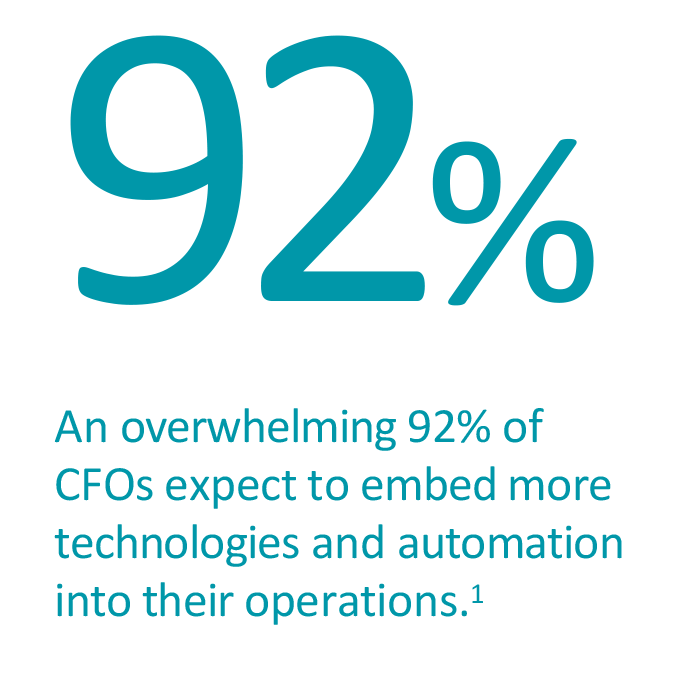Crunch time for CFOs: Novel and exponential technologies in Finance has been saved

Perspectives
Crunch time for CFOs: Novel and exponential technologies in Finance
The NExT frontiers in technology transformation

Crunch time series for CFOs:
Novel and exponential technologies in Finance
The NExT frontiers in technology transformation
Generative AI, language models, machine learning, augmented reality, quantum computing: These hot topics are everywhere, and they likely aren’t going away. Everywhere you turn, it seems like someone is testing the abilities of consumer-facing generative AI applications, such as ChatGPT, AlphaCode, DALL·E, and Bard, and learning their limitations … and potential. And everyone—including Finance leaders—could be wondering what these technologies mean for their work and for the future.
It’s no secret that these leading-edge solutions will likely play an outsized role in Finance’s evolution. Self-service, finance cycles, and enterprise resource planning (ERP) all stand to potentially change because of them. But the question remains: How? The answers will be up to each organization and its leaders. Forward thinking can yield opportunity, but there’s also room for skepticism: about the technology’s limits, about return on investment, and about the ethical downsides that loom amid equity and bias concerns, plagiarism, intellectual property theft, and socioeconomic challenges. These are likely to be new items on every Finance leader’s existing stack of concerns. It’s no wonder that in the face of so much change, another risk can be inertia itself.
With that in mind, we’ve designed a pragmatic guide to the technologies that are likely to disrupt your organization over the next few years. We’ll show you what you should know, what to watch out for, and where to focus. (It might not be where you think.)
What's here:
The original AI (intelligent automation, conversational AI, visual AI, etc.)
We’ve reached the point of talking about "traditional" AI capabilities—ones you’re likely familiar with and may use already. Some Finance organizations have broadly used capabilities like robotic process automation (RPA) and natural language processing (NLP) to automate tasks, streamline individual tasks, and uncover patterns and correlations. These tools have shown they can automate routine activities and reduce human workloads, but they cannot replace human workers when it comes to addressing complexity, ambiguity, or surprises.
Machine learning (ML)
Machine learning is a data analysis method that uses algorithms and historical data to identify patterns and make predictions. The “learning” in its name comes from real-world contexts, not programmed rules. High-volume finance activities that require judgment-based decisions can benefit from ML—in chatbot interactions, predictive forecasting, and tax compliance, for example. But ML can’t work past anomalies or substandard data the way humans can. At least, not yet. For those curious about generative AI, ML could be a start, with similar use cases, but implemented generally faster and less expensively (for now).
Generative AI
Behind the current buzz is a powerful new kind of AI in which machines can create new content that mimics human work—text, code, voices, images, videos, and more. For Finance, the technology’s full potential may still be in the (near) future. For now, though, generative AI can function like an always-on, automated analyst: It can prepare a budget or write a report, but you wouldn’t take its work to the board without checking it yourself. Still, because it can "team up" with humans so quickly and efficiently, generative AI appears likely to spur dramatic changes in finance work in the years ahead.
${header-title}
What’s next:
Augmented reality (AR)
By superimposing digital images over a view of the physical world, AR can build immersive virtual experiences in real time. In finance, the same technology may offer benefits such as experiential learning. When combined with digital twin technology, AR may help simulate production lines, facilities that haven’t been built yet, or even finance workflows. Imagine touring a factory and "seeing" information about production costs and operational expenses superimposed over each part of the line. For now, though, most of the likely uses of AR appear to remain consumer-facing.
What’s for your successor:
Quantum computing
Not a faster or bigger computer, but rather an entirely new kind, quantum machines use deep physics to perform complex tasks at speeds that transcend math itself. The possibilities appear immense, but even the people creating quantum computers are still learning what they’re capable of. For Finance leaders, this could be a technology to keep abreast of, but it’s not one you’re likely to use very soon. Someday, though, it may take AI technologies to new heights—with sophisticated modeling, valuation simulations, and other uses. When quantum comes of age, it may be a disruptive business force.
500,000
Education and resources
- Item One – Lorem ipsum dolor sit amet, consectetur adipiscing elit
- Item Two – Lorem ipsum dolor sit amet, consectetur adipiscing elit
- Item Three – Lorem ipsum dolor sit amet, consectetur adipiscing elit
${column4-large-text}
${column4-title}
A DNA of people, technology, data, and controls
An evolution is based on DNA—and no matter what technologies you incorporate into your Finance function, your tech evolution should rest on a no-regrets foundation of a clean core, data, and security. Key investments in your people, processes, and core technology (which includes the ways you deal with your data) mean you could be better off when you decide to implement leading-edge tech. If Finance can’t trust and scale new tech because the building blocks aren’t there, then the investment likely isn’t worth it.
The common denominator in these novel technologies is that they work with people, not in place of them. That can offer new capabilities, but also could demand new skills. Before you set out to build or acquire those skills, you should answer some foundational questions: What does your organization need? Where will these capabilities live? Can your workers not only learn to use tools like generative AI, but also recognize bias and validate outputs?
Predictive and generative AI are next-gen tools. They may not align well with a last-gen ERP solution. This may be the time to consider implementing a new ERP as a foundation for everything that’s soon to arrive. Finance doesn’t only benefit from this transformation—it can also help guide it, by leading smart decisions about the planning and investment decisions that will shape the new platform.
AI is hungry for information, from more internal and external sources than you may be used to managing. It’s time to get serious about the availability, completeness, standardization, accuracy, and security of the data your Finance function depends on. If you don’t already have a formalized Finance data organization and/or private models, this may be the time to put those structures in place and get your team out of spreadsheets.
Systemic rules and controls are what harness a technology to your business’s strategic goals—and they’re also the keys to mitigating risk and imposing ethical safeguards. Threats of misuse, unintended outcomes, and cyberattack have the potential to mount every time a new technology comes online, so organizations should examine and strengthen their processes—before, not after, they adopt emerging technologies as part of their operations.
It's Crunch time.
If you’ve taken the steps above, you have a foundational road map. Stay true to it. If a new shiny object comes along—and don’t worry, one’s likely already on the way—you should take a step back and consider the fundamentals. How would this technology really create value for my Finance organization and strengthen our position as a business partner? Is this technology really that different from what we’ve already implemented, or is it truly a game changer? Only you and your organization can answer those questions. However, as you move forward, keep in mind: evolution, not revolution. It’s crunch time.
Deloitte can help
Our Finance Labs explore the “art of the possible” and define your Finance Transformation strategy, bringing to life potential use cases, road map priorities, and future-state benefits. Contact us to learn more.
Explore other reports and guides in our Crunch time series, along with inspirational Finance Transformation case studies.
Recommendations
The implications of generative AI in Finance
A new frontier in artificial intelligence and for Finance
Crunch time series for CFOs: It's time to get serious about data
Making data a priority is essential to your finance transformation strategy








